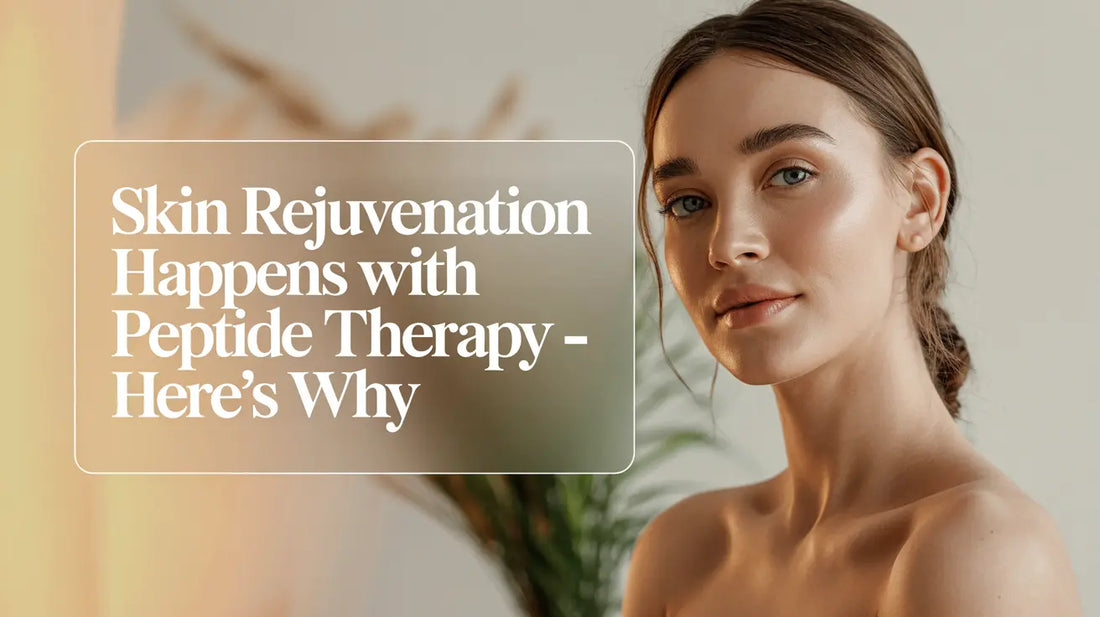
Skin Rejuvenation Happens with Peptide Therapy - Here’s Why
Share
Peptide therapy accelerates skin renewal and tissue repair by stimulating cellular repair, balancing inflammation, and supporting collagen production for faster, clearer, and more resilient skin.
In this article, you’ll learn:
- Core Mechanisms: How peptides drive aesthetic improvements and skin healing
- Top Benefits: Visible outcomes you can expect
- Application Guidelines: Simple dosing and timing tips for peptide strips
- Integration Advice: Combining peptides with standard skincare practices
- Research Highlights: Case examples and emerging findings
Core Mechanisms of Peptide‐Driven Skin Renewal
Peptides like BPC-157, TB-500, and GHK-Cu target key pathways to rebuild and rejuvenate skin:
- Keratinocyte Activation: BPC-157 boosts keratinocyte migration to cover wounds and smooth texture quickly.
- Collagen Remodeling: GHK-Cu regulates collagen types I and III, improving structural support and reducing existing scar formation.
- Elastin Enhancement: TB-500 encourages elastin production, increasing skin elasticity and reducing the appearance of stretch marks.
- Inflammation Balance: BPC-157 and TB-500 modulate cytokines (IL-1β, TNF-α) to prevent chronic redness and support healthy healing.
- Angiogenesis Support: BPC-157 stimulates VEGF pathways for new microvessels, bringing nutrients to damaged areas.
Learn more about foundational repair in Peptide Therapy for Tissue Repair.
Top Benefits of Peptide Therapy for Skin
Incorporating peptide therapy yields a range of aesthetic and functional improvements:
- Faster Scar Reduction: Acne scars and surgical marks fade more quickly as peptides reorganize collagen structures.
- Improved Skin Texture: Smoother, firmer skin results from balanced elastin and collagen networks.
- Reduced Fine Lines & Wrinkles: GHK-Cu’s copper-dependent cross-linking softens both static and dynamic wrinkles.
- Diminished Hyperpigmentation: Peptides regulate melanogenesis to fade sunspots and even skin tone.
- Enhanced Post‐Procedure Recovery: Faster re-epithelialization after laser, microneedling, or chemical peels minimizes downtime and inflammation.
- Calmer Reactive Skin: Conditions like rosacea see reduced redness as peptides repair barrier function and temper inflammation.
- Stronger Scalp & Hair Follicles: Peptides enhance dermal papilla cell health to support robust hair growth and reduce thinning.
Application Guidelines for Peptide Strips
Follow these simple steps to incorporate peptide strips into your skincare routine:

- Dosing: Apply one sublingual strip of InStrips Restore (combining BPC-157 and TB-500) or a GHK-Cu topical gel as directed.
- Timing: Use strips morning and evening for acute concerns; reduce to once daily for maintenance.
- Skin Prep: Cleanse and pat skin dry before applying topical peptide gels to ensure maximal absorption.
- Post‐Use Care: Wait 5–10 minutes before applying other skincare products or makeup to let peptides penetrate.
See specific dosing for wound management in Wound Healing & Skin Regeneration.
Integration Advice with Skincare Regimens
Combine peptide therapy with established practices for optimal results:
- Daily Sunscreen: Protect new collagen from UV damage by applying broad-spectrum SPF 30+ every morning.
- Gentle Cleansing: Choose non‐foaming cleansers to avoid stripping peptides or natural oils.
- Hydration & Nutrition: Support peptide action by maintaining hydration and eating vitamin C and zinc‐rich foods.
- Adjunct Treatments: Use gentle exfoliation (AHA/BHA) once or twice weekly to promote cell turnover alongside peptides.
- Lifestyle Factors: Aim for 7–9 hours of sleep and low stress to complement peptide-driven repair.
Research Highlights & Case Examples
Clinical and anecdotal evidence supports peptide efficacy in aesthetic contexts:
- Acne Scar Trials: Participants saw a 50% reduction in scar depth after 8 weeks of combined BPC-157 and GHK-Cu therapy.
- Stretch Mark Outcomes: TB-500 application demonstrated significant striae fading and improved skin elasticity in small‐scale studies.
- UV Damage Reversal: BPC-157 treatment led to measurable increases in collagen density and decreased MMP activity in photoaged skin.
- Post‐Laser Healing: Patients using peptide strips experienced 30% faster re-epithelialization and reduced erythema after laser resurfacing.
Dive deeper into clinical data in Supportive Research & Case Studies.
Frequently Asked Questions
Here are some questions and answers:
How quickly will I notice aesthetic improvements?
Most users report smoother texture and reduced redness within 2–4 weeks. Scar reduction and hyperpigmentation improvements often appear around 6–8 weeks.
Can I use peptides with other cosmetic procedures?
Yes, combining peptide strips or topical gels with treatments like microneedling or chemical peels usually speeds healing and minimizes inflammation.
Are there any side effects?
Side effects are rare but may include mild tingling at application sites or temporary redness. Always patch-test new peptide products.
Should I cycle peptide therapy?
For ongoing maintenance, reduce to once-daily dosing after initial 6–8 week intensive phase. Cycling helps maintain receptor sensitivity and long-term benefits.
